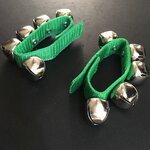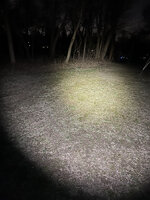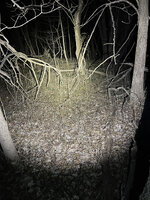You are using an out of date browser. It may not display this or other websites correctly.
You should upgrade or use an alternative browser.
You should upgrade or use an alternative browser.
LED Search Light
- Thread starter TD-Horne
- Start date
 Help Support Candle Power Flashlight Forum
Help Support Candle Power Flashlight Forum
TD-Horne
Newly Enlightened
So they are available in at least 1 flashlight battery form factor we can consider them. I'm not clear on what you meant when you wrote "I am NOT suggesting that you use them,"Do you mean that you wouldn't recommend their use or that you weren't urging their use. Subtle I know. But if they are available in a D cell or C cell form factor that could be a game changer.Actually, they are. I use 16340 size LFP cells in place of CR123As in some of my flashlights (etc). Surefire (just for one example) sells them for use in their flashlights. I am NOT suggesting that you use them, only correcting the record. As you were...
Tom Horne
I see what you mean Poppy. What seems strange to me is that a lot of folks here wrote that the 200 Lumens that the Counselors thought that was needed for a headlight was going to be way to bright. Once they tried some of the ones that folks here suggested they agreed that much less was adequate.These shots were taken at about 800 lumens with a convoy s2+
IMO at 200 lumens, you'll have all you can do to keep from tripping on yourself.
View attachment 41634
View attachment 41635
View attachment 41636
View attachment 41637
I'm going to take a camera and a tripod along on this comparison I'm organizing at the next Young Friends Conference. Some of the High School aged participants have already had experience as assistant counselors so with their input and that of prior staff and counselors who are now serving as adult guides I think they'll come pretty close to something that will work for them. Do you have any ideas for the kinds of things that a camper might drop while wandering around lost. For a large thing I'm thinking of a 1 quart water bottle.

What can anyone suggest for a smaller item. Im going to find out what kind of trail snack they might carry so I can use a wrapper from one as a dropped object.
I won't be the one doing the searching so I'll leave the choice to those who have and will. I'm going to try to get one of each of the ones recommended by several contributors and let some recent counselors and camp staff try them. Their the ones who would best assess their effectiveness. Being 72 I doubt that my eyes would give a useful evaluation of actual effectiveness.
Tom Horne
Nebo big Larry at 500 lumens only runs about 2 hours. It's specified at 8 hours at 209 lumens. For the price, it's probably worth trying out.
aznsx
Flashlight Enthusiast
While I'm at it TD, you might be interested in knowing about the general type of light I have in my hand and am currently playing with in my LR. The primary reason is that, within its area of light radiation / distribution pattern, it has what I would describe as exactly the characteristics you've emphasized repeatedly, in this respect:
The typical radiation patterns of most conventional 'reflector' based lights (or LED variations thereof), emit a central 'hotspot' (which may or may not be an evenly-distributed light pattern within it), then in concentric circles or rings, that is often followed by a 'corona' area, which is then often followed by an area of 'spill' or flood; quite often with very uneven distribution of light across all of those. The light I have here projects what is essentially a perfect circle of light, with absolutely homogenous and consistent / even illumination within that circle, and which has a well-defined outer boundary with practically no 'spill' outside of it. Think of it as one large circular 'hot spot', with homogenous and evenly-distributed illumination out to its boundary, with no real 'spill' or 'flood' area(s) per se. If this one had a lower color temperature (as higher ones like this tend to wash out color / shading details, and also produce much more 'back scatter' due to predominance of shorter wavelengths, which is due to detrimental reflections from aerial haze / particulate matter in the air such as high moisture / humidity levels as are common in your area, particularly at night and in low-lying areas) , and if it had decent 'color rendition' (which it does not), it would probably be exactly what I'd want to use for near-field terrain searching like you're doing.
This light uses a version / type of an increasingly popular type of output management setup commonly referred to as a 'TIR' optic (as in Total Internal Reflection, of fiber optic transmission 101 fame). There are many different specific designs of 'TIR' optics (often utilizing a variation of a reflecting surface(s) and / or a sometimes complex front 'lens' to optimize specific characteristics (for both single and multi-emitter applications) produced by companies like Ledil, Carclo, etc.). Someone more familiar with the current flashlight market than I am may be able to direct you to some photos which illustrate this kind of optic and its characteristic distribution pattern, and perhaps production light(s) incorporating them. I would also, again, recommend something with an appropriate CT (say, 4000-4500K), and relatively high CRI.
Since the one I'm playing with reminds me exactly of some of your descriptions, I thought I'd mention it. Some variant of this could provide ideal illumination characteristics for you.
The typical radiation patterns of most conventional 'reflector' based lights (or LED variations thereof), emit a central 'hotspot' (which may or may not be an evenly-distributed light pattern within it), then in concentric circles or rings, that is often followed by a 'corona' area, which is then often followed by an area of 'spill' or flood; quite often with very uneven distribution of light across all of those. The light I have here projects what is essentially a perfect circle of light, with absolutely homogenous and consistent / even illumination within that circle, and which has a well-defined outer boundary with practically no 'spill' outside of it. Think of it as one large circular 'hot spot', with homogenous and evenly-distributed illumination out to its boundary, with no real 'spill' or 'flood' area(s) per se. If this one had a lower color temperature (as higher ones like this tend to wash out color / shading details, and also produce much more 'back scatter' due to predominance of shorter wavelengths, which is due to detrimental reflections from aerial haze / particulate matter in the air such as high moisture / humidity levels as are common in your area, particularly at night and in low-lying areas) , and if it had decent 'color rendition' (which it does not), it would probably be exactly what I'd want to use for near-field terrain searching like you're doing.
This light uses a version / type of an increasingly popular type of output management setup commonly referred to as a 'TIR' optic (as in Total Internal Reflection, of fiber optic transmission 101 fame). There are many different specific designs of 'TIR' optics (often utilizing a variation of a reflecting surface(s) and / or a sometimes complex front 'lens' to optimize specific characteristics (for both single and multi-emitter applications) produced by companies like Ledil, Carclo, etc.). Someone more familiar with the current flashlight market than I am may be able to direct you to some photos which illustrate this kind of optic and its characteristic distribution pattern, and perhaps production light(s) incorporating them. I would also, again, recommend something with an appropriate CT (say, 4000-4500K), and relatively high CRI.
Since the one I'm playing with reminds me exactly of some of your descriptions, I thought I'd mention it. Some variant of this could provide ideal illumination characteristics for you.
Last edited:
I wasn't part of that conversation, but at least for me, I use a headlamp for tasks where I need both hands, for working on things at arms length, and maybe to see a few yards in front of me. With light bouncing back at you off of things that are at arms length, 200 lumens can be a bit blinding. If you are looking out ahead for signs of your missing hiker, you need more light to pick out details like that dropped water bottle or snack wrapper.I see what you mean Poppy. What seems strange to me is that a lot of folks here wrote that the 200 Lumens that the Counselors thought that was needed for a headlight was going to be way to bright. Once they tried some of the ones that folks here suggested they agreed that much less was adequate.
Also, you should be receiving a package tomorrow via USPS.
It wouldn't hurt to ask Olight if they'd donate or deeply discount a bunch of their Gober safety lights. $14.95 for the single light with a clip. 28 hour runtime. Issue one to every person out on a hike. They have three RGBW LEDs which can be illuminated in red, green, blue, or white, steady or flashing in all four colors, RGB cycle, or blinks SOS in red. There are a lot of low cost multi-port USB chargers available for under $50 so at base camp you could plug in all the Gobers to charge, which they do in about 1.5 hours from minimum.
If you get enough so everyone can wear one front and back, they'll be easy to spot if they get a bit lost.
If you get enough so everyone can wear one front and back, they'll be easy to spot if they get a bit lost.
Shortly, I should have a pair of Maglite ML50L's on their way from California, a 2 cell and a 3 cell. I'll send them your way once they arrive...I'm going to try to get one of each of the ones recommended by several contributors and let some recent counselors and camp staff try them.
TD-Horne
Newly Enlightened
Thank you very much!Shortly, I should have a pair of Maglite ML50L's on their way from California, a 2 cell and a 3 cell. I'll send them your way once they arrive...
Tom Horne
TD-Horne
Newly Enlightened
And So I did.I wasn't part of that conversation, but at least for me, I use a headlamp for tasks where I need both hands, for working on things at arms length, and maybe to see a few yards in front of me. With light bouncing back at you off of things that are at arms length, 200 lumens can be a bit blinding. If you are looking out ahead for signs of your missing hiker, you need more light to pick out details like that dropped water bottle or snack wrapper.
Also, you should be receiving a package tomorrow via USPS.
Thank you very much.
Tom Horne
I was wondering how do you search? As far as I can see, searchlights have basically a narrow beam to find something. A wide beam will illuminate some area ahead, but it will not penetrate into the darkest corners.
For example, I was taught to search with a lantern with a narrow beam - to break the perspective into squares and examine one by one square by square, without leaving the spot. Move to a new point - continue scanning from the beginning in the same way.

Also, looking at a wide area may be less effective than looking at many small areas, since the brain will instinctively be lazy to look at the entire surface and something may escape the eye. Although you can use a combined beam - first inspect everything sequentially with a narrow beam, then look with a wide beam, then check everything again with a narrow beam and again with a wide beam.
Did I understand correctly that the main goal is to find missing children?
Another live hack is to hang bells on each. On your feet or on your hands so that they ring when you move, then they will be very easy to find if they move

For example, I was taught to search with a lantern with a narrow beam - to break the perspective into squares and examine one by one square by square, without leaving the spot. Move to a new point - continue scanning from the beginning in the same way.
Also, looking at a wide area may be less effective than looking at many small areas, since the brain will instinctively be lazy to look at the entire surface and something may escape the eye. Although you can use a combined beam - first inspect everything sequentially with a narrow beam, then look with a wide beam, then check everything again with a narrow beam and again with a wide beam.
Did I understand correctly that the main goal is to find missing children?
Another live hack is to hang bells on each. On your feet or on your hands so that they ring when you move, then they will be very easy to find if they move

Hopefully the camp has a good mental health plan for it's counselors/employees, having to listen to those bells all day, everyday would drive me absolutely bonkers.
Security requires some sacrifice - either convenience or money
I remember one religious camp, there was also no electricity, the children were engaged in growing vegetables and caring for livestock. Instead of games, there were only prayers. In case of violation of discipline, they were flogged with rods and locked up for the night in a separate shed. Also, on Fridays, children were forced to walk with wooden crosses to the nearest hill so that they would understand the suffering of Christ. Then it turned out that the founder of the camp was a sectarian and he was put in jail later. Although in the 18th-19th century or the beginning of the 20th century this was quite a normal upbringing practice. I mean rods and strict discipline. Cross-carrying is an invention of this particular sectarian. It was mainly in the 90s and early 2000s - a lot of sects. Most have now been eliminated.
Last edited:
I bet they left that part out of the brochure. 
kerneldrop
Flashlight Enthusiast
Thermal imaging is the ticket
alpg88
Flashlight Enthusiast
- Joined
- Apr 19, 2005
- Messages
- 5,339
I know you have a tight budget, but maybe a thermal vision would be a lot better to look for a human in a dark woods full of dense vegetation. even better if it is installed on a drone. war in Ukraine showed how effective off the shelf drones and thermal visions are. especially against someone who is not trying to cover their heat signature. they are not cheap, but you are a children's camp, maybe local politicians could be talked into financing such a life saving device.
There are also programs for analyzing data (photos) from drones using neural networks. Helps to find traces of the presence of people much faster than sorting photos manually. This applies to daytime and nighttime shots as well, since a person who is very cold can be missed by a person in a thermal image if the camera is not of very good quality.
I think the new GPT-4 can be taught online
I think the new GPT-4 can be taught online
I think we're talking a tight budget here for something which may not be used even yearly.
The way this is going , pretty soon someone will be talking about LiDAR.
The way this is going , pretty soon someone will be talking about LiDAR.
Expensive purchases, especially the kind that just sit, potentially for years at a time, like a thermal imager in this case, have a tendency to turn off benefactors/donors. I'd leave the fancy thermal imagers and computer algorithms to the people who have deeper pockets. I would bet that the local fire department or some other local agency has a thermal imager that they would be more than happy to deploy when needed.
I know some you guys recommended bells and whistles, but jeez.
I know some you guys recommended bells and whistles, but jeez.
alpg88
Flashlight Enthusiast
- Joined
- Apr 19, 2005
- Messages
- 5,339
It depends small volunteers fire dept are not always equipped with latest and greatest equipment, nor they have many people available. it would take them a lot longer to assemble a SR team, than flying a drone and locating a person.
Also do not think of it as something that has to be used all the time to justify its purchase, think of it as a fire extinguisher, or a first aid kit. Calling FD everytime a kid wanders off is like going to an emergency room every time you have a cramp. It can also damage the camps reputation, and lose customers among other things.
Also do not think of it as something that has to be used all the time to justify its purchase, think of it as a fire extinguisher, or a first aid kit. Calling FD everytime a kid wanders off is like going to an emergency room every time you have a cramp. It can also damage the camps reputation, and lose customers among other things.
a person who is very cold?? lol as in dead? cuz otherwise it is pretty easy to spot one from above, i wont post videos, but you can easy find them, videos of drones in ukraine spotting russian soldiers from above even when they are under thick vegetation. it is not pictures they look at, but a live video feed. those are commercial dji drones with commercially available thermal cameras.There are also programs for analyzing data (photos) from drones using neural networks. Helps to find traces of the presence of people much faster than sorting photos manually. This applies to daytime and nighttime shots as well, since a person who is very cold can be missed by a person in a thermal image if the camera is not of very good quality.
I think the new GPT-4 can be taught online
aznsx
Flashlight Enthusiast
Not to presume to speak for the OP, but I just reviewed post #1, and I believe the OP posted seeking help in selecting some flashlights for use by camping staff.




